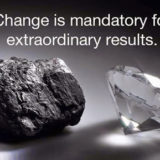

One of today’s current buzz phrases in the management lexicon is that alignment of organizational goals should be aligned throughout an organization. Certainly, this is true, yet it’s often quoted without the real understanding of meaning or importance.
A recent study by Capgemini and the IESE Business School, which surveyed 260 innovation executives globally, found that “large organizations create so much distance between the executives and those that are tasked to innovate that a disconnect exists between them.”
The reason for this disconnects between innovation and creating and driving alignment is derived from the reason for the huge productivity gains the world has seen since the Industrial Revolution. Technology itself is not the reason for this, but rather working practice – the division of labour and specialization.
Management made more difficult by the division of labour and specialization
Before the Industrial Revolution changed the world, the economy was made up of various artisans. If you wanted your horse re-shoed, you visited a blacksmith; bread was bought from a baker, and so on and so forth. In other words, the world was serviced by specialists with little or no coordination required.
In his book, The Wealth of Nations, Adam Smith explained how the division of labour and specialization drives productivity. In a survey of a pin factory, this division produced a 20,000 fold increase in productivity.
However, there are also negative effects from this division. The process of production becomes unstable – a blacksmith keeps all processes under one roof with the process in his head, in a factory environment this becomes unviable. So was born the manager.
The management drive
A good manager is definitely worth his or her weight in gold.
According to a study of an IT project by Wharton University researcher Ethan Mollick, managers account for almost a quarter of the variation in company revenue. Here’s what he found:
“After controlling for many factors, such as the genre of the game and the size of the project, I found that individual producers account for 22.3% of the variation in company revenue. Designers, by contrast, account for just 7.4% of the variation — a relatively marginal impact. For comparison, everything else that’s part of the firm, whether it’s senior managers or strategy or marketing, accounts for just 21.3% of the variation in firm performance.”
Putting the alignment argument to bed
Studying organizations that have managed alignment processes successfully provides for perspective as to the management of such alignment. A good example of this is Sealy, the mattress company.
In 2008, the company faced sagging sales. Its response was to embark on an innovative strategy and introduce new products to the market. Its first step was the realization that mattress design and manufacture involves a number of specialist functions. Sealy created a cross-functional innovation team which employed members from across the firm’s hierarchy. Their task was easy – to design the mattress of the future.
Sealy’s biggest challenge was leadership and management. The failing of management is the reason that 70% of these types of strategy implementations fail. Sealy aligned everyone to its goal, with leadership learning a new way to arrange their organization, breaking down traditional divisive barriers.
Discover the pivot point of your business
Successful alignment largely depends upon the discovery of pivot points: those things that tip separate functions to success. Tim Theriault, the Chief Information, Innovation, and Improvement Officer (CIIIO) at Walgreens saw that all the separate work practices required IT as an enabler of the process, so he coordinated his improvement programs via the IT department.
Further, he is personally involved with the creation and implementation of roadmaps which aligns management with strategy, and vision, company-wide. Results to date speak for themselves: between $50 million and $100 million of yielded benefits with expectations this will reach over $1 billion.
Where managers of innovation and change need to focus
It is imperative for managers to realize the very thing that makes an organization so productive also makes it unstable. Too often management focus leans toward reducing the ‘span of control’ with the aim of reducing inefficiencies. Instead, this only succeeds in reducing organizational effectiveness.
Managers should instead focus on alignment and coordination to produce major innovative and change success. As both Sealy and Walgreens have discovered, doing so drives significant bottom line improvements.
Want to Learn More About Change Management?
I’ve created a free eBook on Fundamentals of Change Management. In this eBook, you’ll learn the fundamentals of change management, why it’s critical to achieve business outcomes, as well as tools and techniques to make change work for you. Click Here to Download.











